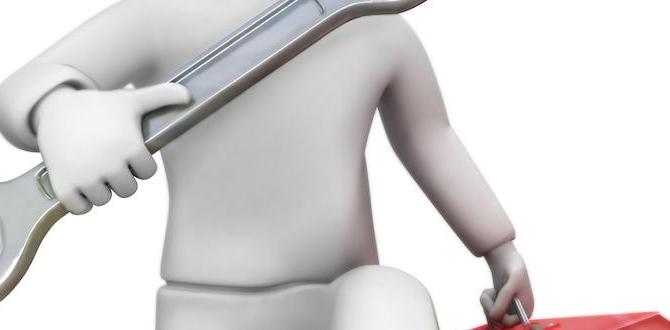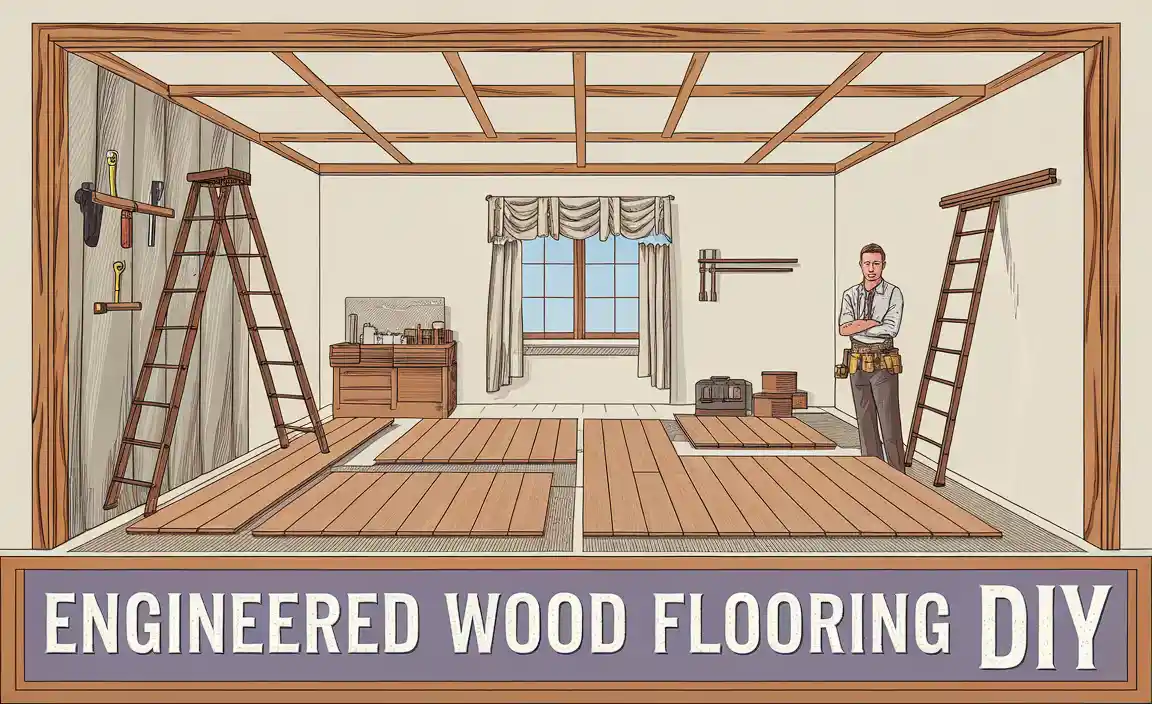Have you ever tried to nail something and realized it was harder than it looked? Using a finish nailer can change that. This handy tool makes nailing quick and easy. Imagine building a beautiful bookshelf or crafting a cozy frame for your favorite picture. Sounds fun, right?
Many people often wonder how to use a finish nailer safely and effectively. It’s not just for the experts. Anyone can pick it up and get started. Just think about all the projects you can complete. In this article, we will explore the ins and outs of using a finish nailer.
Did you know that finish nailers shoot nails that are thinner than regular nails? This helps reduce splitting in delicate wood. Isn’t that a neat trick? Stay tuned as we dive deeper into how to use a finish nailer, making your DIY adventures easier and more enjoyable!
Table of Contents
How To Use A Finish Nailer: Tips And Techniques For Success

How to Use a Finish Nailer
Using a finish nailer can make your woodworking projects easier and faster. First, ensure you have the right safety gear, like goggles and gloves. Adjust the nail depth for your specific material. Start by holding the nailer firmly against the surface. Did you know a finish nailer can drive nails without splitting the wood? Release the trigger and watch the nail go in smoothly. Practice on scrap wood first if you’re unsure. Enjoy creating beautiful pieces with confidence!Understanding Finish Nailers
Definition and purpose of a finish nailer. Different types of finish nailers available on the market.A finish nailer is a handy tool used for attaching trim and molding to surfaces. It’s like a magic wand for woodworkers! Think of it as a superhero that shoots out tiny nails without needing a hammer. There are two main types of finish nailers: pneumatic, which uses air, and cordless, which runs on batteries. Each has its own superpowers, so choose wisely!
| Type | Power Source | Best for |
|---|---|---|
| Pneumatic Finish Nailer | Air Compressor | Heavy-duty tasks |
| Cordless Finish Nailer | Batteries | Quick projects |
Choosing the Right Finish Nailer
Key features to consider when selecting a finish nailer. Comparison between pneumatic, cordless, and electric finish nailers.Choosing a finish nailer is an important decision. You should think about key features like power source, weight, and depth adjustment. Here are some main types:
- Pneumatic Finish Nailers: Use air compressors. They are strong and great for heavy tasks.
- Cordless Finish Nailers: Run on batteries. They are easy to move around but may have less power.
- Electric Finish Nailers: Plug into outlets. They are quiet and simple to use.
Pick the one that fits your project needs best!
What features should I look for in a finish nailer?
Look for power, weight, and ease of use. These are key to making your project smooth. Good features help make nailing easier!
Essential Safety Precautions
Protective equipment needed when using a finish nailer. Common safety practices to follow during operation.Using a finish nailer is exciting, but safety comes first. Always wear protective gear like goggles, ear protection, and gloves. This keeps you safe from flying debris and loud sounds. Follow these safety practices during operation:
- Keep your hands away from the nailer’s tip.
- Never point it at anyone.
- Be aware of your surroundings.
By taking these steps, you can enjoy your projects and stay safe! Did you know that most accidents could be avoided with proper safety gear? It’s true!
What protective gear do I need for a finish nailer?
You need goggles to protect your eyes, earplugs for your ears, and gloves for your hands.
Preparing for Use
Necessary tools and materials for finish nailing. Steps for setting up your workspace effectively.Before you dive into your finish nailing project, it’s essential to gather your tools and materials. Grab your finish nailer, safety goggles, and ear protection, and don’t forget a sturdy work surface. You’ll also need nails, wood pieces, and a measuring tape. A bit like preparing for a big party, you want everything in place!
| Necessary Tools | Materials Needed |
|---|---|
| Finish nailer | Finish nails |
| Safety goggles | Wood pieces |
| Ear protection | Tape measure |
Next, let’s set up your workspace. Make sure it’s clean and well-lit—tripping over tools is not a great look! Arrange your materials so they’re close at hand. An organized area speeds things up and helps you avoid those “uh-oh” moments when hunting for a missing nail. A tidy workspace leads to a tidy project and a happy you!
Techniques for Proper Operation
Stepbystep guide on how to load and adjust the finish nailer. Best practices for nailing techniques and angles.Using a finish nailer is easy with the right techniques. First, load the nails properly. Open the magazine and place the nails inside. Close it securely. Next, adjust the depth setting. This controls how deep the nails go into the wood.
For best results:
- Aim the nailer straight at the surface.
- Hold it steady while firing.
- Use a slight angle for corners.
- Practice on scrap wood first.
Always wear safety glasses. This keeps your eyes safe from flying debris. Take your time and be careful. With practice, you’ll use the finish nailer like a pro!
How do I load and adjust a finish nailer?
To load and adjust a finish nailer, open the magazine, insert the nails, and close it firmly. Adjust the depth by turning the knob on the tool until you achieve your desired setting.
What is the best angle for nailing?
The best angle is a slight tilt towards the wood. This helps the nail go in without splitting the material. Remember, steady hands make for better results!
Common Mistakes to Avoid
Highlighting frequent errors made by beginners. Tips for troubleshooting and correcting mistakes.Using a finish nailer can be tricky for beginners. One common mistake is holding the tool at a wrong angle. This can lead to bent nails or damage. Another error is not adjusting the pressure, which may cause nails to sink too deep or stick out like they’re trying to make a dramatic exit! Always check the nail size before shooting—using the wrong size can cause jams. If you do make a mistake, take a breath, and remember this: you can fix it!
| Error | Solution |
|---|---|
| Wrong angle | Keep it straight! |
| Pressure issues | Adjust to the surface type. |
| Incorrect nail size | Always double-check! |
Maintenance and Care for Your Finish Nailer
Importance of regular maintenance and cleaning. How to store and protect your finish nailer for longevity.Keeping your finish nailer in top shape is key for great projects. Regularly cleaning it makes sure it works well and lasts longer. Think of it like brushing your teeth; neglect it, and things can get messy! Store your finish nailer in a cool, dry place. A toolbox or a safe shelf is perfect. Protect it from dust and moisture, so it won’t rust. With a little care, your nailer will be your best buddy for years!
| Maintenance Task | Frequency |
|---|---|
| Clean exterior | After each use |
| Check air filter | Weekly |
| Oil moving parts | Monthly |
Advanced Tips and Techniques
Techniques for achieving professionallooking finishes. Creative projects where finish nailers can be utilized effectively.To make your projects look professional, consider these key tips:
- Choose the right size of nail for your materials.
- Space your nails evenly for a clean look.
- Use wood filler for holes to create a smooth finish.
- Sand lightly before painting or staining.
Finish nailers work well in creative projects. Use them for:
- Building furniture like chairs and tables.
- Decorating with crown molding.
- Making picture frames or shelves.
These techniques and ideas can elevate your work. With practice, you’ll achieve beautiful results.
What makes a finish nailer useful for projects?
A finish nailer provides quick, strong connections for fine woodworking. It helps create seamless joints and holds materials securely together.
Quick tips for effective use:
- Always wear safety gear.
- Check for air leaks before starting.
- Practice on scrap wood first.
Conclusion
In summary, using a finish nailer makes your projects easier and cleaner. Remember to adjust the depth and hold it steady. Always wear safety gear to protect yourself. Practice on scrap wood before your main project. Now that you know the basics, dive in and start creating! For more tips, check out beginner guides on finish nailers.FAQs
Sure! Here Are Five Related Questions On How To Use A Finish Nailer:Sure! Here are five questions about using a finish nailer. First, make sure to wear safety glasses to protect your eyes. Next, hold the nailer firmly against the spot where you want to put the nail. Then, pull the trigger to shoot the nail into the wood. After that, check if the nail is straight and secure. Finally, always unplug it when you’re done using it!
Sure! Please provide the question you’d like me to answer.
What Safety Precautions Should I Take Before Using A Finish Nailer?Before using a finish nailer, here are some safety tips to follow. First, always wear safety glasses to protect your eyes. Next, make sure to keep your fingers away from the end of the nailer. Check that the tool is not loaded before you carry it. Finally, only use it in a safe area and never point it at anyone.
How Do I Choose The Right Size Nails For My Finish Nailer?To choose the right size nails for your finish nailer, start by checking the nailer’s manual. Usually, you should use nails that are 1.25 inches to 2.5 inches long. Thicker nails hold better but can leave bigger holes. It’s best to match the nail size to the thickness of the wood you are using. Always practice safe use when handling tools!
What Techniques Should I Use For Setting Nails Flush With The Surface?To set nails flush with the surface, you can use a hammer gently. Hold the nail with one hand and tap it lightly. If the nail sticks out too much, you can use a nail set. A nail set is a tool that helps push the nail deeper. Be careful not to hit your fingers!
How Do I Properly Maintain And Clean My Finish Nailer To Ensure Optimal Performance?To keep your finish nailer working well, start by unplugging it or removing its battery. Then, clean it with a soft cloth to remove dust and dirt. Check the nozzle for jams or stuck nails and clear them carefully. Lastly, add a few drops of oil to the moving parts to keep them smooth. Doing this will help your nailer work better!
What Types Of Projects Are Best Suited For Using A Finish Nailer?A finish nailer is great for tiny projects where you want a clean look. You can use it for trim work, like putting up baseboards or crown molding. It’s also good for making furniture, like chairs or tables. You can even use it for decorating by attaching small pieces without showing nails. Overall, it helps make your work neat and pretty!


